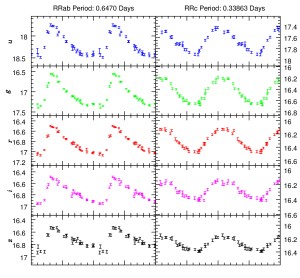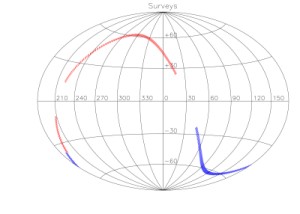Background:
One of the outstanding issues in galactic astronomy is trying to
understand the formation history of the Milky Way halo. The first major paper to try and
tackle this issue was Eggen, Lynden-Bell, and Sandage (ELS) in 1962.
Looking at the orbits of metal-poor stars, they came to believe that
the halo was formed by a giant collapsing primordial cloud. This view
was challenged in 1978 by a paper by Searle & Zinn (SZ). They argued
that a collapse from a single giant cloud would produce a trend in the
metal-content of stars as a function of distance from the center,
which they did not see. As a result, they suggested that the halo in
fact formed from a bunch of small clouds coming together.
Things went back and forth for some time until a paper by Bekki & Chiba came out
in 2001. They suggested that it was something of a mixture of the
two. In their models, they found that one would build up the galaxy
starting with large gas clouds which would form stars more like ELS,
and then smaller clouds would add onto the orginal clouds more like SZ. This
concept gained even more traction when in 1994 Ibata et al. discovered the
remnants of a dwarf galaxy which had been consumed by the Milky Way. It was
called the Sagitarius stream. Later on in 2003, Majewski et al. actually
described the shape of the Sagitarius stream.
This Project:
One of the major components of the second phase of the Sloan Digitial Sky Survey
(SDSS-II) is the Supernova Survey. This survey
covers a strip in the sky about degrees in height and about 120 degrees wide
centered on the
celestial equator. This survey involved looking at the strip over and over
again to find changes in the night sky, which could be supernovas. As a side
effect to this, they also found many RR Lyrae variable stars. RR Lyrae stars have
several important characteristics. The first is that they are readily seperated
from other stars by looking at their lightcurve (a plot of change in brightness as
a function of time). Secondly, they are what are known as standard candles, which
basically means that they have a know intrinsic brightness. Since we know how
bright they should and we know how bright we measure them to be, we can figure out
the distance to them. Finally, their lightcurve shape and the period of their
pulsations, tells us something about their internal makeup. This allows us to use
them as tracer stars for different components of the halo. By studying their
metallicities, their period, and their kinnematics we can say something about the
environment they formed in, which ultimately tells us about how our halo was formed.
For more information you can click on my
2007 AAS poster or on my
talk from the 2007
Stellar Pulsation conference.
|





